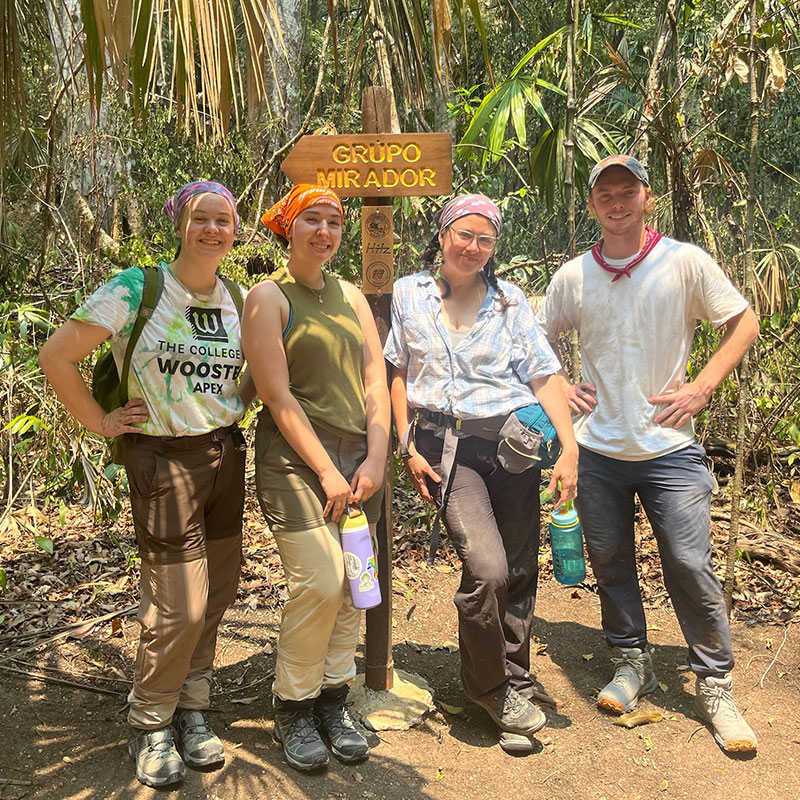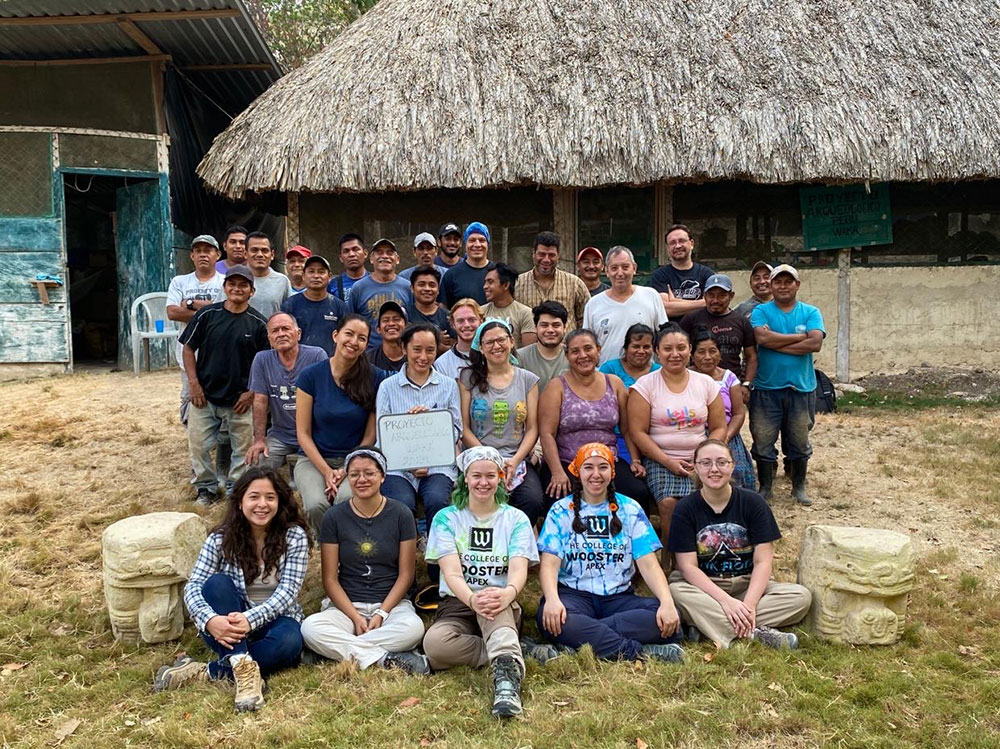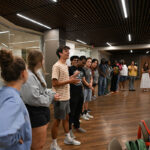
Archaeology major draws conclusions about Maya political systems based on excavation on site in Guatemala

Archaeology major Henry McMahon spent the summer before his senior year at The College of Wooster in Guatemala surveying an ancient plaza inside El Perú-Waka´ with his faculty mentor, Olivia Navarro-Farr, associate professor of archaeology and anthropology at the College and co-director of the Proyecto Arqueológico Waka’ (PAW) team of the archaeological site located in the Laguna del Tigre National Park within the Maya Biosphere Reserve. Studying the 8th to 11th century A.D. site gave context to what would become his senior Independent Study project.
For his I.S. McMahon, who played midfield on the Fighting Scots lacrosse team, investigated a transitional time in the ancient Maya city of El Perú-Waka’ in Peten, Guatemala, as leadership shifted within the culture.
“As the power of kings and queens begins to dwindle, new political systems start to take shape,” said McMahon. “I was trying to determine what these systems may have looked like, as well as determine if they were collaborative in nature.”
What he found about the construction of a possible Maya council house indicated that the newly formed political system that began to take shape during the late phases of when it was occupied was more collaborative in nature. “I also found it very likely that this new movement was not in opposition to the ruler of the time, Aj Yax Chow Pat, as the council house was constructed in the immediate proximity of the royal palace,” McMahon said. “Had the city’s final ruler seen this action as a threat, he would have most definitely struck this movement down.”
What excites you about your I.S.?
McMahon: I have the opportunity to contribute to discussions that are currently being held in the field of meso-archaeology. It is also a vein of questioning that can be continued for future projects, which I have already started to do.
How did Wooster prepare you for designing your project?
McMahon: Wooster prepared me for the intense collaboration that is required when carrying out this type of research. Wooster has also shown me that failing or pivoting is always part of the process. During the early portions of my initial research, I had to shift my investigations to utilize the resources that I had available to me which ultimately led to an incredibly rewarding and rich experience.
In what ways has your relationship with you I.S. mentor supported you throughout this process?
McMahon: I was incredibly lucky to have such a dedicated and caring advisor. Dr. Navarro-Farr is not only insightful into the rich world of Maya archaeology but is also astute in understanding her students. I.S. is a long and sometimes exhausting process, you cannot always be giving 100%. Dr. Navarro-Farr was very understanding and understood that sometimes rest was the best strategy for moving forward productively.
What has I.S. taught you?
McMahon: I.S. has taught me that your first draft or idea doesn’t need to be your most polished. Sometimes the fear of making something perfect can stop you from starting all together. Just go for it and think on your feet!

While on site with the Proyecto Arqueológico Waka’ (PAW) team, students become part of a community of workmen, archaeologists, kitchen staff, drivers and others that all work to make the field season go smoothly. Included among the team for the summer 2024 season is Henry McMahon ’24 in the center and students from Wooster and other schools in the front row from left to right, Maria Jose Valasquez (Universidad del Valle de Guatemala), Diana Torres (Universidad del Valle de Guatemala), Teagan Knutson ’25 (Wooster), Sydney Berenson ’25 (Wooster), and Emily Bertin (Bloomsburg University, PA).
Studying the period of upheaval following the fail of the monarchy through the lens the archaeological remains left behind inspired a continuing interest for McMahon, who plans to pursue a Ph.D. in archaeology. After graduation, he returned to El Perú-Waka´ with Navarro-Farr to continue his research. In his initial research he pointed out that the collaborative political system may not have been entirely successful as the city was largely abandoned before the construction of the council house was completed. “I would also like to continue research by investigation what the function of these possible council houses may have truly been,” he said. “Much of the evidence for these arguments was destroyed during the contact period.”
Featured photo: Along with Henry McMahon ’24 (far right), students from the left Teagan Knutson ’25, Sydney Berenson ’25, also worked on site with Olivia Navarro-Farr (center right), associate professor of archaeology and anthropology at the College and co-director of the Proyecto Arqueológico Waka’ (PAW) team at the archaeological site located in the Laguna del Tigre National Park within the Maya Biosphere Reserve in summer 2024. Here, the group from Wooster stands at the front of the trail leading to the Mirador Group, consisting of the two of the largest pyramids at the site.
Posted in Homepage Featured, Independent Study on June 30, 2024.
Related Posts
Related Areas of Study
Museum Studies
The Museum Studies minor requires six courses, with one required course and the remaining to be selected from experiential and theory courses. Alongside MUST […]
MinorWomen's, Gender, & Sexuality Studies
Champion the experiences of women as they intersect with race, nation, ability, class, religion, and other axes of difference
Major MinorMuseum & Archival Studies
Explore the diverse traditions of collection, curation, research, display, and preservation and plan your career
PathwayArchaeology
Fieldwork and research are a big part of the study of prehistoric and historical archaeology
Major MinorAnthropology
Use problem-solving and research skills to explore and understand communities and cultures in every part of the world.
Major Minor

